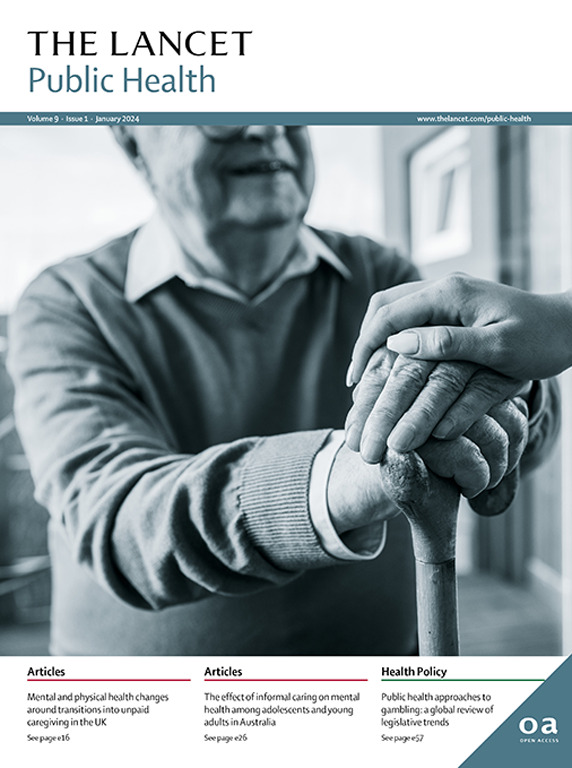50 years of comprehensive state-wide data on pregnancy termination in South Australia: a retrospective, population-based, cohort study
IF 25.4
1区 医学
Q1 PUBLIC, ENVIRONMENTAL & OCCUPATIONAL HEALTH
引用次数: 0
Abstract
Background
Termination of pregnancy is a common procedure, accessed globally, irrespective of logistical and legal barriers. We aimed to document changes in procedural characteristics and demographic factors over time in South Australia, as well as to examine how key sociodemographic variables affect gestational age at pregnancy termination.Methods
South Australian legislation has required mandatory collection of data related to pregnancy termination since 1970. We conducted a retrospective population-based cohort study of all pregnancy terminations in the state from 1970 to 2020. The primary outcome was gestational age at termination of pregnancy. Linear regression was used to examine socioeconomic characteristics that could confer disadvantage in access to pregnancy termination, with postcodes coded according to the 2016 Australian Statistical Geographical Classification–Remote Area system and the Index of Relative Socio-Economic Advantage and Disadvantage (IRSAD) from the Australian Bureau of Statistics 2018.Findings
Between Jan 1, 1970, and Dec 31, 2020, 225 440 pregnancy terminations were performed at a median of 8 weeks’ gestation (IQR 7–10). Most pregnant individuals (median age 24 years [IQR 20–31]) resided in urban areas (n=166 311 [77·9%]) and received surgical pregnancy termination (n=287 345 [78·4%]). Major complication rates remained low over time; however, major complications occurred more frequently at higher gestational ages. Gestational age at pregnancy termination decreased over time (from 9 weeks [IQR 8–11] in years 1970–75 to 7 weeks [6–9] in years 2016–20) and was strongly correlated with being a teenager (ie, aged <20 years), rurality, and IRSAD score, with individuals at greater levels of socioeconomic disadvantage undergoing pregnancy termination at consistently higher gestational ages.Interpretation
Over time, there have been many changes in the demographics of women and the method used for pregnancy termination. Even in a high-income country with legal and publicly funded access to pregnancy termination, there are significant differences in the gestational age at which pregnancy termination occurs, which vary with socioeconomic disadvantage. Understanding changes in the demographics of those undergoing this procedure and the influence of various indicators of socioeconomic disadvantage is vital for optimal service provision.Funding
None.南澳大利亚州终止妊娠 50 年来的全州综合数据:一项基于人口的回顾性队列研究
背景终止妊娠是一种常见的手术,在全球范围内均可实施,不受后勤和法律障碍的影响。我们旨在记录南澳大利亚州的程序特征和人口因素随时间推移而发生的变化,并研究主要社会人口变量如何影响终止妊娠时的妊娠年龄。我们对该州 1970 年至 2020 年间所有终止妊娠的孕妇进行了一项基于人口的回顾性队列研究。主要结果是终止妊娠时的孕龄。研究采用线性回归法来检验可能导致终止妊娠方面处于不利地位的社会经济特征,根据2016年澳大利亚统计地理分类-偏远地区系统和2018年澳大利亚统计局的相对社会经济优势和劣势指数(IRSAD)对邮编进行编码。研究结果1970年1月1日至2020年12月31日期间,共有225 440例终止妊娠,妊娠中位数为8周(IQR为7-10)。大多数孕妇(中位年龄 24 岁 [IQR 20-31])居住在城市地区(人数=166 311 [77-9%]),并接受了手术终止妊娠(人数=287 345 [78-4%])。随着时间的推移,主要并发症的发生率仍然很低;但是,主要并发症在妊娠年龄越大的情况下发生得越频繁。随着时间的推移,终止妊娠时的胎龄有所下降(从1970-75年的9周[IQR 8-11]降至2016-20年的7周[6-9]),并且与青少年(即年龄为20岁)、农村地区和IRSAD评分密切相关,社会经济条件较差的人在较高的胎龄进行终止妊娠。即使在高收入国家,终止妊娠也是合法的,并由政府资助,但终止妊娠的孕龄却存在显著差异,这与社会经济地位的弱势有关。了解接受这种手术的人口统计学变化以及各种社会经济弱势指标的影响,对于提供最佳服务至关重要。
本文章由计算机程序翻译,如有差异,请以英文原文为准。
求助全文
约1分钟内获得全文
求助全文
来源期刊

Lancet Public Health
Medicine-Public Health, Environmental and Occupational Health
CiteScore
55.60
自引率
0.80%
发文量
305
审稿时长
8 weeks
期刊介绍:
The Lancet Public Health is committed to tackling the most pressing issues across all aspects of public health. We have a strong commitment to using science to improve health equity and social justice. In line with the values and vision of The Lancet, we take a broad and inclusive approach to public health and are interested in interdisciplinary research.
We publish a range of content types that can advance public health policies and outcomes. These include Articles, Review, Comment, and Correspondence. Learn more about the types of papers we publish.
 求助内容:
求助内容: 应助结果提醒方式:
应助结果提醒方式:


